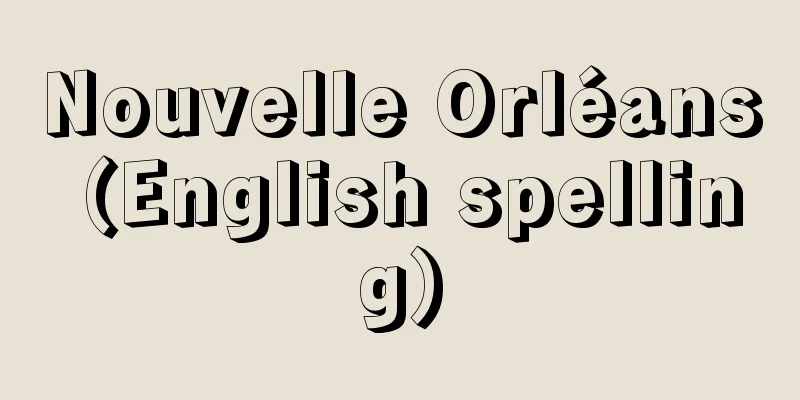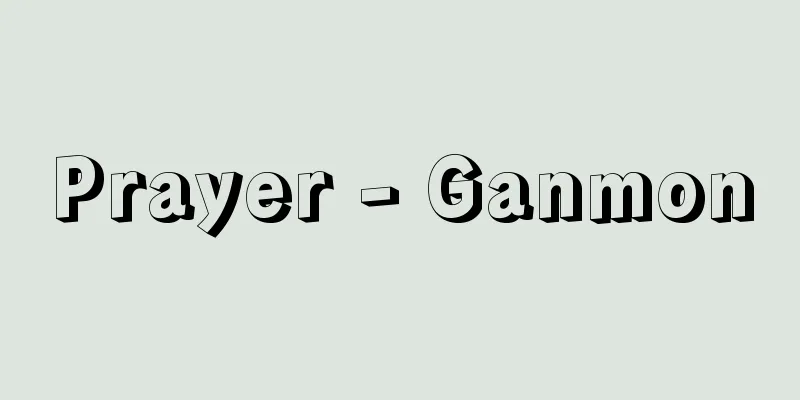Popular Song - Kayo

|
When we refer to popular music broadly, it is not limited to language or letters, but if we think of it as popular literature, it is mediated by words, has an oral and musical nature, and extends into a pre-literature realm that is not consciously considered literature. [Tokue Motomasa] JapanIn ancient times, folk songs were called uta or utafu . The beginning of waka poetry is said to be in the opening line of the Kojiki, "Yakumo tatsu...", by Susanoo-no-Mikoto. The preface to the Kokin Wakashu, written in kana, traces its origin back to the 55 chants by the male and female gods Izanagi-no-Mikoto and Izanami-no-Mikoto, and the 577 chants by Yamato Takeru-no-Mikoto and Mihitaki-no-Okina in the Tsukuba Mondo. Utafu is closely related to kataru (speaking), yomi (reading), and asobu ( playing ), and requires consideration not only of the lyrics, but also of the melody, dance, and other aspects of music and the performing arts. There are various theories about the origin of the word uta , but it is thought to come from uchi (to strike), which means to give a strong and intense shock to the soul of the other person through the power of words. The ancient songs found in the 190 poems (excluding duplicates) in the Kojiki and Nihon Shoki, as well as in the Kinkafu, were later collected and stored in the Utama Izukasa and Oouta Dokoro, and were called daiuta when they included folk songs . Folk songs are often found in the Fudoki and Manyoshu, and there are many folk songs such as those from Utagaki and Azuma Uta. During the Middle Ages (Heian period), Kagura songs were selected, Azuma Asobi, originally a dance from the eastern provinces, began to be performed at various shrines, Saibara, which was popular along with recitation, combined the customs of the time with the melody of Chinese music, and all of these were performed in aristocratic society. Ceremonies for Shomyo (Buddhist songs) were held, and the new type of Imayo (modern-day Japanese songs) became popular, and the Buddhist song Wasan also incorporated Shinto songs, and the Ryojin Hisho (Ryōjin Hishō) was compiled, a collection of 560 poems in the narrow sense of Imayo, consisting of 754 verses. In the Middle Ages (Kamakura and Muromachi periods), various Ennen songs emerged as a continuation of miscellaneous arts, and in the eastern cultural sphere, Enkyoku (fairy songs) were born, and the "Enkyokushu" (Collection of Enkyoku) was compiled. As for storytelling, Heikyoku (a type of music performed by a Biwa priest) became popular, and this trend was passed down to Joruri (a type of puppet theatre) and Sekkyo (a type of sermon). Wasan (traditional Japanese hymn) also flourished, and during the Northern and Southern Courts, Noh songs and Kōwaka dances were performed, and short songs such as Kōta arose from the general public, which led to the creation of the "Kanginshu" (Collection of Kan'ginshu). The vestiges of these were passed down to Kōtai (short songs) and Kyogen Kōta (short songs), and were passed down to the next generation through the "Sōan Kōtashu" and Ryutatsubushi (Collection of Ryutatsubushi). In the late Middle Ages, with the popularity of Furyu Dance, many dance songs in the style of group songs were created, and these have been passed down as being rich in folklore, along with the Taue Soshi, a collection of rice planting songs from the western part of the country. In the early modern period (Edo period), the introduction of the shamisen added a level of splendor and sophistication, and the Nembutsu dance, which combined the elegant dance and Nembutsu from the previous era, became deeply connected to female Kabuki, promoting diversification. Many of them originated in Kamigata and reached completion in Edo, and Kamigata songs and jiuta developed into Edo Nagauta, and Matsu no Ha includes kumiuta, chouta, and hauta, while the flow of kouta from the previous era perfected the 3-4-4-3-4-5 rhythm, and brought about the popularity of nagebushi from rosai and katabachi. In the early days, Joruri including Kinpira-bushi was introduced to the Kansai region, and Gidayu-bushi was perfected. This style of song was performed together with various schools of Sokyo music. During the Meiji period, Naniwabushi, a genre of biwa-uta and chongare , was popular, and military songs, hymns, children's songs with literary figures involved in writing the lyrics, wartime national songs, and after the Second World War, popular songs became very popular, while folk songs were reevaluated. Although it is not a battle between men and women, the folk event of Kakeuta in Akita Prefecture can be considered a modern-day "song contest." Many Shinto rituals and performing arts, even if they do not date back to ancient times, still retain melodies reminiscent of medieval popular songs, and the Japanese people's love of song extends to the popularity of amateur singing contests, karaoke, and singing battles, which continue to this day. [Tokue Motomasa] ChinaThe Book of Songs, which contains songs from the 9th century BC to the 7th century BC, is the oldest collection of Chinese songs. In addition to simple folk songs such as love songs and work songs collected from all over the Yellow River basin, there are also many ceremonial and religious songs. In the Han dynasty, songs called 'Gafu' appeared. 'Gafu' was originally the name of the office in charge of musical compositions, but later came to refer to songs sung to the accompaniment of music in general. Song songs from the Han dynasty through to the Tang and Five Dynasties were collected in the 'Gafu Poetry Collection' compiled by Guo Maoqian of the Song dynasty. Among these, songs based on folk songs from the Chu region of the Han dynasty vividly sing of love and life and are considered the quintessence of Gafu. Moving on, songs such as Zi Ye Ge from the Southern Dynasties are also not to be missed as they convey the sensuality of the bustling streets. During the Tang Dynasty, music from the Western Regions was introduced, and from the height of the Tang Dynasty through to the Song Dynasty, lyrics were added to these new melodies and sung. These lyrics, called shi, retain their elegant and delicate emotionality to this day. Eventually, shi blossomed into a verse form separate from music. In the Yuan dynasty, a type of folk song known as sanqu emerged. Music centered on string instruments was brought in from the north along with foreign tribes, giving rise to a wide variety of melodies. Sanqu became popular when it was incorporated into the singing portion of a type of opera called Yuanqu. Making full use of slang, the content ranged from lyrical to narrative, and sometimes even satirical, and was welcomed by the common people. In the Ming and Qing dynasties, sanqu lost its originality, but it continued to develop as it was incorporated into the singing portions of spoken works such as drum zither and danshi. After the Ming Dynasty, handicrafts developed, especially in Jiangnan, and folk songs from various regions flowed into the cities. The Ming Dynasty's "Mountain Songs," compiled by Feng Menglong, contains many simple folk songs from various regions, mainly love songs, and their vulgar versions. After the founding of the People's Republic of China, the spotlight was focused on traditional folk songs from various regions, and many new folk songs were created with new themes. On the other hand, modern songs are also popular. [Masanobu Kikuta] WesternIts origins are unclear, but Orpheus, who descended to the underworld to mourn his dead wife and performed the lyre for King Pluto, was allowed to return to the mortal world but was unable to do so, and can be said to be the ancestor of song and music. In the 6th century BC, Pindar appeared and completed the ode (Epinikion), a victor's hymn that is indispensable to the Olympiads. Later, it was inherited by the Roman Horace, and was further revived by the French Ronsard. Also in the same 6th century BC, there was Sappho, who was born on the island of Lesbos. She was a priestess of Aphrodite, and was the first female poet in Western Europe to write and sing Sapphic quatrains that explode with passion and sadness at parting, loving many women. Anacreon, who lived in the same period, did not show such an outpouring of passion, but he left behind 30 songs of earthly enjoyment, which were later called Anacreontic. On the other hand, the Old Testament shows the essence of religious hymns in the Song of Songs and the Psalms, the former of which is said to have been composed by Solomon and the latter by David. However, the songs that sang these hymns have been lost and there is no way to know. Churches that were organized in the 3rd and 4th centuries had their own liturgical hymns in various parts of the East, but at the end of the 6th century, they were unified and organized by Pope Gregory VI, laying the foundation for today's church music. The passionate love between bride and groom seen in the Song of Songs is a symbolic expression of Christian faith. From the beginning of the 12th century to the middle of the 13th century, the idea of lady worship arose throughout Europe, starting from southern France. Poets (some of whom were kings or nobles) wrote elaborate poems expressing their unrequited love for the ladies of their hearts, set them to music, and dedicated them to the ladies. This was the origin of the so-called romantic love poetry seen in European literature. There are hundreds of names of poets who remain today, and they were called troubadours in southern France, trouberts in northern France, and Minnesengers in Germany. In the 14th century, the so-called fixed-form poems such as chansons, ballads, motets, rondeaux, and rondelles took shape, and the melodies to sing them were ingeniously developed, ushering in the heyday of medieval popular music. The masters of this style include Guillaume de Machaut and Eustache Dechamps (1346-1406/07). In addition to these original poems, simple folk songs, such as "Song of the Farewell of the Silken Nuns," "Pastoure," and "Mar Marie," a song about a woman in an unhappy marriage, began to be sung even among the upper classes of the nobility. A major achievement in the field of song in 15th-century Italy was the creation of the sonnet, a fixed-form poem. Together with the canzone, it soon swept across Western Europe. In Germany, on the other hand, new hymns were created in conjunction with the reformist religion of Luther, and a flood of hymns accompanied by organ music occurred. In contrast, in France, led by Ronsard, a movement to promote language and poetry arose, reviving almost all forms of Greek and Roman style. Ronsard in particular wrote Pindar's solemn odes and great classical epic poems praising the founding of France, but on the other hand, this resulted in the separation of poetry and song. In particular, the pure tragedies of the 17th century banished music from drama, and while beautiful French rhythms could be heard, music was completely stripped from drama, and instead opera was born. In contrast, Pre-Romanticism, which arose in the second half of the 18th century, promoted ideas of nature and nation, and collected folk songs from border countries, Scotland, Spain, Greece, and other countries. This marked the prelude to the heyday of song in the 19th century, and included ancient poems such as Ossian, Burns' songs in the Scottish dialect, Thomson's The Seasons (1726-30), Bürger's Leonore (1774), Tressent's Romances (late 18th century), Wordsworth and Coleridge's Lyric Songs (1798), and Heine's Songbook (1827). [Teruo Sato] "Compilation of Japanese Popular Songs, edited by Takano Tatsuyuki, 12 volumes and 5 volumes (1960-69, Tokyodo)" ▽ "Compilation of Japanese Popular Song Research Materials, edited by Asano Kenji, Shida Nobuyoshi, Hirano Kenji and others, 10 volumes in total (1976-82, Benseisha)" ▽ "History of Japanese Popular Songs, by Takano Tatsuyuki (1926, Shunjusha/reprint edition, 1981, Satsuki Shobo)" ▽ "History of the Japanese Popular Song Sphere, by Shida Nobuyoshi (1968, Shibundo)" ▽ "Japanese Popular Song Literature, edited by Usuda Jingorō and others (1975, Ohfusha)" ▽ "Japanese Popular Songs, edited by Nakanishi Susumu and Niima Shinichi (1975, Kawade Shobo Shinsha)" ▽ "Selections of Chinese Poetry and Prose 23: Yuefu and Sanqu, by Tanaka Kenji (1983, Chikuma Shobo)" [Reference] |Source: Shogakukan Encyclopedia Nipponica About Encyclopedia Nipponica Information | Legend |
|
広く歌謡という場合には言語・文字にとらわれないが、歌謡文学としてとらえるならば、ことばを媒介とするもので、口承性・音楽性を有し、文学と意識されない文学以前の領域にまでわたる。 [徳江元正] 日本歌謡を、古代にはうた・うたふといった。『古事記』の冒頭須佐之男命(すさのおのみこと)の「八雲(やくも)立つ……」を和歌の始まりとし、『古今和歌集』仮名序では伊弉諾尊(いざなぎのみこと)・伊弉冉尊(いざなみのみこと)男女二神による55の唱和に、『筑波問答(つくばもんどう)』では日本武尊(やまとたけるのみこと)と御火焼之老人(みひたきのおきな)との577の唱和にさかのぼってその始原を求めている。うたふはかたる・よむ・あそぶなどとも密接なかかわりをもち、詞章のみならず、その旋律・舞いぶりなど音楽・芸能面からの考察をも必須(ひっす)とする。うたの語源には諸説あるが、言霊(ことだま)によって相手の魂に強く激しい衝撃を与える意の「打つ」からきたものと考えられる。『古事記』『日本書紀』の190首(重複を除く)や『琴歌譜(きんかふ)』にみられる古代歌謡は、のちに雅楽寮(うたまいづかさ)・大歌所(おおうたどころ)に集められ保管され、民間のうたをもくみ上げて大歌とよばれたが、民間のものは『風土記(ふどき)』や『万葉集』などに多くみられ、歌垣(うたがき)のときのものや東歌(あずまうた)など民謡も少なくない。 中古(平安時代)には、神楽歌(かぐらうた)が選定され、もと東国の歌舞である東遊(あずまあそび)が諸社で行われるようになり、朗詠とともにもてはやされた催馬楽(さいばら)は、風俗(ふぞく)を唐楽の旋律に合わせたもので、これらはいずれも貴族社会で行われた。声明(しょうみょう)(仏教歌謡)の講式がおこり、郢曲(えいきょく)・雑芸(ぞうげい)や新興歌謡の今様(いまよう)が流行し、仏教歌謡の和讃(わさん)は神事歌謡をも摂取し、754句からなる狭義の今様560首の集成『梁塵秘抄(りょうじんひしょう)』が編まれた。 中世(鎌倉・室町時代)になると、雑芸からの流れとして、延年(えんねん)の諸歌謡があり、東国文化圏にあっては宴曲(えんきょく)(早歌(そうが))を生み出し、『宴曲集』が編まれた。語物(かたりもの)としては、琵琶(びわ)法師による平曲(へいきょく)が流行し、この流れは浄瑠璃(じょうるり)・説経(せっきょう)などへ受け継がれた。前代以来の和讃も盛行し、南北朝には謡曲・幸若(こうわか)舞曲が行われ、短小のものでは民間から小歌(こうた)がおこってきて、『閑吟集(かんぎんしゅう)』成立の気運をもたらし、それらのおもかげは、小謡(こうたい)や狂言小歌などに伝えられ、『宗安(そうあん)小歌集』や隆達節(りゅうたつぶし)を経て次の時代に受け継がれてゆく。中世末期には、風流踊(ふりゅうおどり)の盛行に伴い、組歌風の踊歌が多く生み出され、西国の田植歌の集成である『田植草紙』とともに民俗性豊かなものとして伝えられている。 近世(江戸時代)は、三味線の渡来によって一段と華やかさと洗練の度とを加え、前代からの風流踊と念仏とが一体化した念仏踊から女歌舞伎(おんなかぶき)と深くかかわり合い、多様化を促進した。多くは上方(かみがた)で発生し江戸で達成をみるという経路をとり、上方歌・地歌は江戸長唄(ながうた)へ展開し、『松の葉』は組歌・長歌・端歌(はうた)を収め、前代以来の小歌の流れは、三四四三三四五調を完成させ、弄斎(ろうさい)・片撥(かたばち)から投節(なげぶし)の盛行を招来した。初期には、金平節(きんぴらぶし)をはじめとする浄瑠璃が上方に伝わり、義太夫節(ぎだゆうぶし)が大成、この語物系統の歌謡は、諸派の箏曲(そうきょく)とともに行われた。 明治期には、琵琶(びわ)歌・ちょんがれの系統の浪花節(なにわぶし)が流行し、時勢に応じた軍歌、賛美歌、作詞に文人が参加した童謡、戦時下の国民歌謡、また第二次世界大戦後は歌謡曲が大流行する一方、民謡が再評価された。男女による応酬ではないが、秋田県の民俗行事カケウタは現代の「歌争ひ」ともいえる。多くの神事や芸能のなかには、古代まではさかのぼれなくとも、中古の歌謡の旋律を思わせるものは少なからず残存しており、日本民族の歌好きの風は、いまに衰えぬのど自慢素人(しろうと)コンクール、カラオケ、歌合戦の人気にまで及んでいる。 [徳江元正] 中国紀元前9世紀から前7世紀ごろまでの歌謡を収めた『詩経(しきょう)』は中国最古の歌謡集といえる。黄河流域各地から集められた恋歌、作業歌などの素朴な民謡のほか、儀礼的、宗教的歌謡が多数みえる。 漢代になると楽府(がふ)とよばれる歌謡が現れる。楽府とは、もと楽曲をつかさどる役所の名であるが、のち管弦にあわせて歌う歌謡一般の呼び名となった。漢以後、唐・五代に至る楽府は、宋(そう)の郭茂倩(かくもせん)編『楽府詩集』に集められている。そのうち、漢代楚(そ)地方の民謡を基にした歌謡は、愛情や生活が生き生きと歌われ、楽府の精華とされる。下って南朝の子夜歌(しやか)に代表される歌謡も繁華な巷(ちまた)の艶情(えんじょう)を伝えて見逃せない。 唐代、西域(せいいき)の音楽が移入されると、盛唐のころから宋代にかけて、この新しい旋律に歌詞がつけられて歌われた。その歌詞を詞(し)というが、艶麗で繊細な情緒をいまに残している。詞はやがて、音楽から離れた韻文形式として開花する。 元代に入ると、散曲(さんきょく)とよばれる歌謡がおこる。北方からの異民族とともに、弦楽器を中心とする音楽がもたらされ、多様な旋律が生まれたことも背景にあるであろう。散曲は元曲(げんきょく)という一種の歌劇の唱(うた)の部分にも組み込まれて盛行する。俗語を駆使し、内容も叙情から叙事にわたり、ときに風刺を交え、庶民に歓迎された。明(みん)・清(しん)代には、散曲はその清新さを失うが、一方、鼓詞(こし)や弾詞(だんし)などの語物の歌唱部分に取り入れられて発展するのである。 明代以降、江南を中心として手工業が発展、各地の民謡が都市に流入した。明の馮夢龍(ふうぼうりゅう)編『山歌(さんか)』には、各地の山歌とよばれる、恋歌を主とする素朴な民謡や、その俗曲化したものが多数収められている。 中華人民共和国成立後、各地の伝統的な民謡に光があてられ、新しい内容が歌い込まれて多くの新民歌が生まれている。一方で、近代的な歌曲も盛んである。 [菊田正信] 西洋その起源は模糊(もこ)としてうかがい知れないが、死んだ妻をしのんで冥界(めいかい)に降(くだ)り、王プルトの前でリラを必死に演じて現世帰還を許されながら果たせなかったオルフェウスこそ、さしずめ歌謡楽人の祖といえよう。紀元前6世紀になると、オリンピアードに欠くことのできない勝者賛歌のオード(エピニキオン)の作者であるピンダロスが出て、これを完成。のち、ローマのホラティウスがこれを継承し、さらにフランスのロンサールがこれを復興した。また、同じ前6世紀にはレスボスの島に生まれたサッフォーがある。彼女はさしずめアフロディテの巫女(みこ)で、多くの女性を愛し、情炎と惜別の哀感を炸裂(さくれつ)するようなサフィック・バース四行詩に書いて歌った西欧最初の女流詩人であった。同じく同時代のアナクレオンにはそのような情熱の奔騰はみられないが、後世いわゆるアナクレオンティックと称される現世享楽の歌謡30編が残されている。一方『旧約聖書』は『雅歌』と『詩篇(しへん)』とをもって宗教賛歌の精髄を示しているが、前者はソロモンの作、後者はダビデによってつくられたといわれる。しかし、これを歌った歌曲は失われて知るよしもない。3、4世紀のころに至って組織化された教会は、東方各地にそれぞれ典礼の聖歌曲をもったが、6世紀末グレゴリウス6世によって統一整理されて今日の教会音楽の基礎を固めた。雅歌にみる、花嫁と花婿との纏綿(てんめん)たる情熱はキリスト教的信仰の象徴的表現である。 12世紀初頭から13世紀の中ごろにかけて、南フランスを起点としてヨーロッパ各地に貴女崇拝の理念が生じ、詩人(なかには王公貴族もいる)は心の貴女に寄せる報われることない愛の欣求(ごんぐ)を精練に精練を重ねた詩に歌い込み、それに自ら曲をつけて貴婦人の前で歌って捧(ささ)げた。これがヨーロッパ文学にみるいわゆるロマンチックな愛の詩の祖である。いまに残されている詩人の名は数百あり、これが南フランスではトルーバドゥール、北フランスではトルーベール、ドイツではミンネゼンガーとよばれた。14世紀に入ると、シャンソン、バラード、モテット、ロンドー、ロンデルなどの、いわゆる定型詩が形を整え、それを歌う旋律にくふうが凝らされて、中世歌謡曲全盛の時代に入る。ギヨーム・ド・マショー、ウスタシュ・デシャンEustache Dechamps(1346―1406/07)などがその名手である。これらのいわば創作詩のほかに、素朴な民謡が――たとえば『きぬぎぬの別れの歌』『パストゥーレル』『マル・マリエ』とよばれて不幸な結婚をした女の歌などの民間の歌謡が、しかも上層貴族の間にあってさえ歌われるようになる。 歌謡における15世紀イタリアでの大きな収穫は定型詩ソネットの創造であろう。カンツォーネとともにやがて西欧を風靡(ふうび)する。これに対してドイツでは、ルターの革新宗教に随伴して聖歌の新作がおこり、オルガンの伴奏によって聖歌曲が氾濫(はんらん)する。これに反してフランスでは、ロンサールを盟主とする言語ならびに詩歌の高揚運動がおこり、ギリシア・ローマのほとんどあらゆる様式の復興、なかでもロンサールはピンダロスの荘重オード、フランス建国をことほぐ古典的叙事詩の大作を書くが、一面、詩と謡を引き離す結果となった。ことに、17世紀の純正悲劇は劇から音楽を追放した結果、美しいフランス語のリズムは聞かれても音楽は完全に劇から剥(は)ぎとられ、かわってオペラが生まれ出る。これに反して18世紀後半におこったプレロマンティシズムは、自然と民族の思想を打ち出し、辺境諸国、スコットランド、スペイン、ギリシアなどの民謡が収集され、『オシアン』の古詩、バーンズのスコットランド方言による歌曲、トムソンの『四季』(1726~30)、ビュルガーの『レオノーレ』(1774)、トレサン伯の『ロマンス』(18世紀後半)、ワーズワースとコールリッジの『叙情民謡集』(1798)、ハイネの『歌の本』(1827)など、19世紀の歌曲全盛の序曲が始まる。 [佐藤輝夫] 『高野辰之編『日本歌謡集成』正12巻・続5巻(1960~69・東京堂)』▽『浅野建二・志田延義・平野健次他編『日本歌謡研究資料集成』全10巻(1976~82・勉誠社)』▽『高野辰之著『日本歌謡史』(1926・春秋社/復刻版・1981・五月書房)』▽『志田延義著『日本歌謡圏史』(1968・至文堂)』▽『臼田甚五郎他編著『日本歌謡文学』(1975・桜楓社)』▽『中西進・新間進一編著『日本の歌謡』(1975・河出書房新社)』▽『田中謙二著『中国詩文選23 楽府・散曲』(1983・筑摩書房)』 [参照項目] |出典 小学館 日本大百科全書(ニッポニカ)日本大百科全書(ニッポニカ)について 情報 | 凡例 |
Recommend
Ek, Mats
Born April 18, 1945 in Malmo, Sweden. Son of dance...
Rotary Compressor - Kaiten Ashukuki
A machine that pressurizes fluid by rotating an im...
Pohang - Pohang
Located in the southeastern part of North Gyeongs...
'Abd al-Laṭīf al-Baghdādī
1162‐1231 A man of many talents and culture, he wa...
Chinju no Mori - Shrine Forest
The grove surrounding a shrine dedicated to the gu...
Wyss, JR (English spelling) WyssJR
...T. Jansson of Finland created a mysterious wor...
Bombina orientalis (English spelling) Bombina orientalis
… [Takahiro Matsui]. … *Some of the terminology t...
《Astrée》(English spelling) Astree
…He sided with the Catholics during the Wars of R...
Family precepts - Kakun
Parents leave instructions to their descendants i...
Froghopper
...The bubbles of the larvae are very conspicuous...
Cassandros
...After the death of the great king, a conflict ...
Betsuin - Branch temple
〘Noun〙① A temple that was built separately from th...
Horse-drawn bird - Horse-drawn bird
…An animal phylum within the invertebrates. It is...
Fuwa Banzaemon - Fuwa Banzaemon
The protagonist of the kabuki play "Sayato.&q...
Tokugawa Tsunayoshi
The 5th Shogun of the Edo Shogunate. The fourth s...


![Landrace [seed] - Landrace](/upload/images/67cd230aa8a27.webp)






